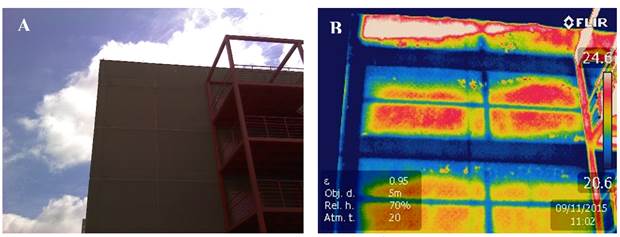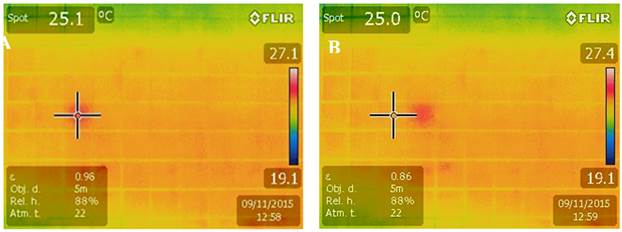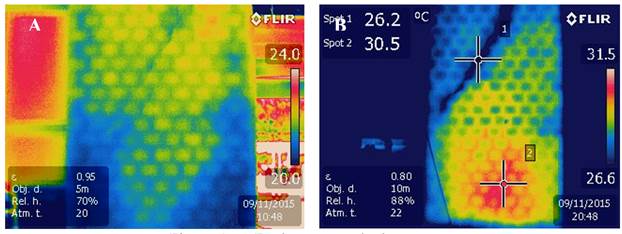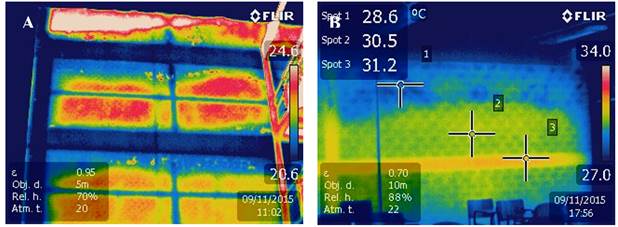1. INTRODUCTION
The building sector is one of the economic foundations of the country and it has evolved as much in constructive techniques as it has in building material development. However, the pathological manifestations in constructions continue to occur, possibly originating in the project phases, from execution or from usage and operation (Santos, 2013).
The absence of detailed projects or failures in its conception and compatibility, the wrong choosing of constructive systems and/or execution techniques, errors during material definition and specification, in quality and technological control, and environmental factors from the construction site region, during execution as well as usage and operation, may cause direct and indirect problems to constructions and owners, users or not of the properties (Santos, 2013).
According to Carvalho Jr. et. al, (1999) in the case of façades, the cladding pathological manifestations compromise the image of engineering and architecture in the country, being an aggression to population perspective, to construction integrity and injuring the concepts of habitability. In addition to the natural depreciation of the property due to visual aspects, the cladding basis, without the appropriate final finishing, becomes vulnerable to water and gas infiltrations, therefore leading to severe building deterioration of aesthetic or structural order.
Due to severity, potential risk of accidents and material damage and its implications, the investigation of pathological manifestations in façades may involve the investigation of pathologies as well as of constructive processes used, assessing quality, safety and performance criteria through document analysis, visual inspections and site and laboratory tests required to give foundation to technical reports (Gomide, 2006).
In this regard, the investigation technique of the present article was based on nondestructive testing (NDT) through thermographic analysis that enables the identification of thermal anomalies in façade cladding systems, linking them to the analysis of typology and found damage extension, demonstrating the technique potentialities for both identifying and mapping the preexisting pathological manifestations.
2. LITERATURE REVIEW
2.1 Investigation of pathological manifestations
The systematization of investigation practices and the gathering of pathological manifestation information in building façades has been studied for a long time and by many authors (Mazer et al, 2016; Romero et al, 2011; Japiassú et al, 2014; Galletto, Andrello, 2013).
According to Gomide (2006), the façade inspections begin with in loco visual investigations of the damaged areas physical conditions. Such exams provide fundamental technical information to the inspection and assist in determining the problem cause and indicating its solution. In addition, the author states that such data collections are complicated due to approximated viewing difficulties of all the façade areas, recommending the utilization of additional technical procedures in the inspection.
In this type of situation, it becomes necessary to take advantage of other resources that may allow a meticulous visualization required for the data collection, whether they are direct or indirect. The mapping with tests consists on direct data collection with annotation in the blueprints of the damaged areas through the observation, by percussion, when descending along the façade, in a Bosun’s chair or suspended scaffold. The indirect resource usually used in this type of investigation consists in photographically mapping the façade (Gomide, 2006). Another usable indirect resource is the façade thermographic mapping analysis.
2.2 Thermography principles
Thermography is a nondestructive and noninvasive inspection technique that has its base on the detection of infrared radiation naturally emitted by the bodies with intensity proportional to its temperature. This technique enables the identification of regions, or points, where the temperature is altered in relation to a preestablished pattern. It is based on the measurement of electromagnetic radiation emitted by a body in a temperature above absolute zero (Bauer, 2013).
The technique may be classified in active and passive according to the thermal excitation used. For the passive thermography, a natural temperature differential between the sample and the current environment is necessary, that is, no artificial thermal stimulation is used. For the active thermography, an external stimulus is imperative to induce the thermal contrasts between the sample and the environment (Maldague, 2001; Bauer, 2013).
The infrared radiation cannot be detected by the human eye; therefore, the infrared camera has the function of acquiring and processing data, presenting images that describe the temperature variations in the target objects (FLIR, 2012).
The radioactive properties of objects generally are described in relation to a perfect black-body, that is, a perfect emitter/absorber of radiant energy. In the real world, there are no perfect emitter/absorber objects; however, it is possible to find objects with properties that are really close to those characteristics (FLIR, 2012).
Considering that the energy emitted by a perfect black-body is denoted by W bb and that the energy emitted by a regular object in the same temperature is denoted by W obj , the relation between these two values describes the object emissivity ε, as indicated in (1).
Therefore, the emissivity is a value that varies from 0 to 1 and the better are the radiant object properties, the higher its emissivity is.
An object that has the same emissivity in all the wave-lengths is called a grey-body. The emission energy (W) of these bodies is determined by the Stefan-Bolzmann Law, presented in (2):
Where ε is the object emissivity, σ is the Stefan-Boltzmann constant and T is the temperature. Besides the object radiation in analysis, the camera lenses receive radiations from the surrounding environment that are reflected in the object surface. These two radiation components are attenuated by the atmosphere that also absorbs and emits in its own way part of the radiation (FLIR, 2012).
Given the previous premises, the total received radiation (W tot ) by the camera may be written as follows in (3):
Where ε is the object emissivity, τ is the transmission through the atmosphere, W amb is the effective energy from the surrounding object environment (or the energy reflected by the environment) and W atm is the energy present in the atmosphere between the object and the camera.
2.3 Thermographic techniques in the façade investigation
The growing utilization of the infrared thermography in civil construction is intrinsically related to the fact that it is a nondestructive test, presenting itself as a great diagnostic tool (Soares, 2014).
With the infrared thermography it is only possible to detect anomalies associated to measurable modifications of the thermal characteristics, such as heat flow and resulting temperatures, and pathological manifestations with limited depths, in other words, close to surface (Pavón, 2015).
Laboratory studies demonstrate that adherence failures or mortar absence behind the ceramic claddings are easily identifiable through thermography, presenting superior superficial temperatures during the positive heat flow period than in the surrounding area, and inferior superficial temperatures during the negative heat flow period (Bauer et al, 2015).
In a study by Edis et al. (2014), it was demonstrated that it is also possible to identify areas with the presence of confined moisture under the ceramic claddings. This situation is configurated by the identification of anomalies in superficial temperatures of the suspected areas in ceramic claddings during the positive heat flow, characteristics of detachment problems or of areas with presence of moisture.
For the case of façades coated with mortar and painting/texture, it is possible to identify other types of pathological manifestation such as fissures and moisture. Fissures are frequently associated with the presence of moisture, and the extension of affected areas is easily identifiable during the day, because water evaporation causes a reduction in superficial temperature within these regions. Similarly, the presence of moisture in masonry walls and concrete structures due to capillarity is also easily identifiable during the positive heat flow period (Pavon, 2015).
Menezes et al (2015) performed inspection campaigns of several anomalies using visual inspections, thermography, percussion tests, karsten tube and hygrometer tests in order to formulate a field methodology for investigating the pathological manifestations in claddings. As a result of the study, it was verified that the visual inspections together with qualitative thermography were sufficient in the fast identification of most of the found anomalies, especially for allowing the inspection of places with difficult access.
In civil construction, a temperature variation from 1ºC to 2ºC is usually an indicative or a suspicion of problem existence. Over 4ºC it is possible to affirm the existence of abnormality in the body (Maldague e Marinetti, 1996; Cortizo et al., 2008).
For Bauer (2013), the main influences in the results of quantitative thermographic inspections are in the material emissivity, which is function of the superficial temperature and of the observation angle; in the surface reflectivity, function of the direct incident radiation and of the radiation of close objects; and in the atmospheric mitigation, function of the meteorological conditions.
3. METHODOLOGICAL PROCEDURES
First, an exploratory study was conducted on the façades of blocks B and C at Campus Curitiba, Ecoville headquarters of UTFPR for the purpose of investigating the anomalies occurrence and the existent types of pathological manifestations through qualitative visual and thermographic inspections to define the study areas.
Secondly, the characterization of the study areas was carried out and the calibration parameters of the calibration camera were defined, consisting in the determination of material emissivity, ambient temperature, humidity and distance between the thermal imager and the analyzed images during the confirmatory study.
Finally, the obtained thermograms were analyzed and compared in the exploratory study as well as in the confirmatory campaign with the intention of verifying if the found thermal anomalies may be linked to the existing pathological manifestations in the studied areas.
3.1 Infrared camera specification
A FLIR infrared camera (thermal imager), model E60, was used during the inspections. The camera personalized calibration parameters consist on emissivity, ambient temperature, reflected temperature, air relative humidity and distance to the object.
The equipment technical main specifications are presented in Board 1:
Board 1 Technical specifications of the Infrared Camera FLIR E60.
| Model | FLIR E60 |
| IR Resolution | 320 x 240 pixels |
| Digital Camera Resolution | 3.1 MP |
| Thermal Sensitivity | < 0.05 °C |
| Precision | +- 2 °C or +- 2% of reading |
| Temperature range | (-20.00 °C a 650.00 °C) |
| Spectral range | 7.5 a 13µm |
| Field of vision (FOV) | 25° |
| Focus | Manual |
| Uncooled microbolometer | LWIR (Long Wave InfraRed) |
| Colorful Display | 3.5” (320 x 240) |
| Frame Rate | 60Hz |
| Mobile measuring points | 3 |
| File format (Thermogram) | Radiometric JPG |
Fonte: FLIR - Infrared Camera Manual, model E60 (2015).
3.2 Exploratory study and definition of study areas
The exploratory study consisted in the visual and thermographic inspection of the blocks B and C façades of the Ecoville headquarters of the Federal Technological University of Parana - UTFPR. The choice study areas was made during the morning period through visual inspections of the existing anomalies in the façades, and also qualitative thermographic inspections to identify the temperature gradients in different regions of a same material, setting the device using the standard emissivity parameter of concrete (ε=0.95) and the parameters of ambient temperature (20ºC) and air relative humidity (70%). During inspection, the climate conditions were stable, without the presence of rain, partially cloudy and without the occurrence of wind.
The façade cladding systems found in the exploratory study consisted of external concrete brick masonry with white paint (IJ Block); external concrete brick masonry, mortar plaster and light gray acrylic texture (Blocks A, B and C); and ceramic cladding applied over mortar plaster (Blocks B and C).
Bellow, boards will be presented together with pictures and thermograms obtained in the exploratory study followed by a brief description of the interferences, found thermal anomalies and possibly associated pathological manifestations.
In Figure 1 is presented the study area 1, defined in the Block C façade, along with its region thermogram.
Points with damaged grout joints between the ceramic tiles around the window framing region were identified in the visual exam of study area 1 presented in Figure 1A.
Additionally, the percussion test detected hollow sounds in wall parts and window framing regions. Figure 1B shows a thermogram where it is possible to identify thermal anomalies in part of the façade executed with ceramic tiles during the positive heat flow in region with direct exposure to solar irradiation during the morning period.
The visual inspection performed in study area 2, presented in Figure A, verified the existence of fissures in the cladding. Additionally, the percussion test detected hollow sounds along the entire fissure region and bellow the fissure.
In the thermogram presented in Figure 2B it is possible to identify a thermal anomaly in part of the façade during a positive heat flow period in region with no direct exposure to solar irradiation during the morning period. The characteristic anomaly from the presence of moisture identified by the thermogram, together with the presence of a fissure in the cladding and the coating detachment, infers the presence of moisture in the inferior region, between the mortar plaster and the concrete brick masonry.
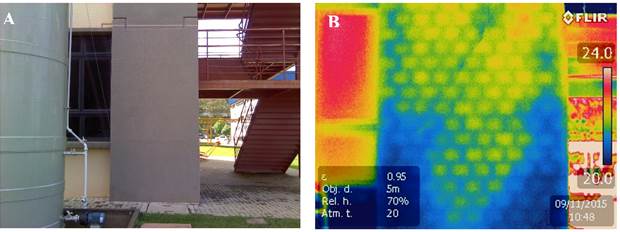
Figure 2 A) Part of Block C façade consisted of light gray acrylic texture over mortar plaster. B) Thermogram of study area 2.
In study area 3, shown in Figure 3A, it is possible to observe block B lateral façade executed with light gray acrylic texture over mortar plaster applied in a concrete brick masonry during the positive heat flow period in a region with no direct exposure to solar irradiation during the morning period.
In the thermogram presented in Figure 3B it is possible to observe a thermal anomaly in the interface region between the concrete brick masonry and the structural beam above, which is a characteristic of moisture presence. Likewise, it is possible to identify the structural elements, concrete tie beams that hold the concrete brick masonry walls and the more elevated temperature in the roof parapet wall region exposed to solar irradiation.
3.3 Determination of the thermal imager calibration parameters
Once the study areas were defined, field tests were carried out to determine the emissivity of the materials found. The tests consisted in determining the emissivity of the façade materials by comparing their surface temperatures with the temperatures of a material with known emissivity and in thermal stability with the analyzed surface.
For the material emissivity determination tests, pieces of black insulating tape adhered to the surface were used. The configuration parameters set for the thermal imager were:
Measuring distance: 5m.
Ambient temperature: 22 °C
Air Relative Humidity: 88%
Isolating tape Emissivity: 0.96.
The test consisted in measuring the surface temperature of the insulation tape, thermally stable with the surface indicated by point A, followed by the measurement of temperature in the material region to be analyzed, indicated by point B, modifying the emissivity parameter of the thermal imager until the temperature indicated at point B is equal to the temperature measurement indicated on the insulating tape surface. Figure 4 shows the calibration performed on the thermal imager for a ceramic cladding.
This procedure was performed for all claddings found in the study areas. The emissivity values found are presented in Table 1.
Table 1 Obtained values of the material emissivity of the study areas.
| Surface | Emissivity |
| Gray acrylic texture | 0.80 |
| Red ceramic cladding | 0.86 |
| Blue ceramic cladding | 0.86 |
| White painting over concrete bricks | 0.70 |
Fonte: Own authorship.
As the emissivity parameter used in the exploratory study was fixated, the thermographic inspection of this stage was qualitative, since the absolute temperature values of the surfaces did not reflect their real values. Nevertheless, the thermograms obtained in the exploratory study were entirely able to identify temperature gradients characteristic of the thermal anomalies in the inspected regions.
3.4 Confirmatory studies with the thermal imager
The confirmatory study sought to obtain complementary information on the heat flow dynamics of the study areas 1, 2 and 3 surfaces in order to confirm the preliminary suspicions about the potential pathological manifestations observed.
On the evening of the same day, the thermal imager was used in the study areas with a quantitative character, setting the equipment with the emissivity parameter obtained in Table 1 and the parameters of ambient temperature (22° C) and relative air humidity (88%).
Figure 5 shows the exploratory and confirmatory study thermograms of the study area 1.
In the confirmatory study of study area 1, presented in Figure 5B, it is possible to identify a thermal anomaly that may be associated to a possible detachment with presence of moisture below the ceramic cladding in the window framing region, since the presence of moisture in the region has the characteristic of maintaining higher temperatures in the thermograms during the negative heat flow period in comparison to the unaffected region. This hypothesis is reinforced by the identification of points with damaged grout between the ceramic tiles in the window region. It is also possible to observe in the exploratory study thermogram, shown in Figure 5A, that during the positive heat flow period the temperatures in the window framing regions are smaller due to water evaporation.
A fissure was observed in the cladding of study area 2, as presented by the thermograms shown in Figure 6.
In the exploratory study thermogram, shown in Figure 6A, it is possible to observe the existence of a thermal gradient in the lower part of the façade and a diagonal line, with temperatures lower than the central part of the façade. In the confirmatory study thermogram, illustrated in Figure 6B, it is possible to verify the existence of the diagonal fissure, marked by point 1, and the region with mortar plaster detachment together with moisture presence marked by point 2, with a higher temperature due to the ability water has of retaining heat during negative heat flow periods when compared to that of cladding materials.
The exploratory and confirmatory study thermograms of study area 3 are presented in Figure 7.
In the exploratory study shown in Figure 7A, it is possible to observe the existing temperature variation, indicating lower temperatures in regions close to beams. In Figure 5B, obtained from the last floor interior, it is possible to observe a thermal anomaly in the region of the interface region between the concrete brick masonry and the structural beam above. The presence of moisture was evident in the interior of the building due to mold presence on walls in the humid region identified by the thermogram.
In addition, a visual inspection was carried out in the external region, due to the possibility of access by the fire scape ladder, from where it was verified the presence of a fissure in the entire extension of the interface region between the concrete brick masonry and the structural beam above in the affected region, thus allowing water infiltration into the building.
4. RESULTS AND DISCUSSION
The capacity of identifying thermal anomalies associated with pathological manifestations through thermography expedites the inspection process and allows the characterization of areas that should be subjected to more rigorous investigations, either by performing confirmatory thermographic studies or by using other field or laboratory tests.
Although it is relatively simple to use a thermal imager to obtain thermograms during the inspections, if the interferences and the environmental conditions in which the images were obtained are not taken into consideration, the analysis and interpretation of the thermograms can lead to mistaken conclusions. In order to avoid this, the theoretical background and the equipment usage experience to identify the thermal anomalies, characteristic from the investigated pathological manifestations, are fundamental to obtain the adequate basis for its interpretation and, consequently, to correctly associate its characteristics with the correspondent pathological manifestations.
Regarding the calibration parameters of the thermal imager, the emissivity values and other environmental parameters must be determined for each inspection situation when it is intended to obtain thermograms with precise temperature measurements of the analyzes surfaces, that is, in quantitative analyzes. For the identification of anomalies in a qualitative manner, these influence parameters do not impair the identification of temperature gradients on surfaces of the same material, a fact confirmed in the exploratory study.
However, the determination of the correct parameters must always be performed to support the analysis and interpretation of thermal anomalies for the diagnosis of pathological manifestations.
The behavior dynamics of the surface heat flows and the deviations associated to certain pathological manifestations are also factors that require attention during the thermogram inspections and analysis. The determination of the best inspection and condition periods may assist obtaining thermograms that evidence the thermal anomalies that may be associated to pathological manifestations.
Regarding the determination of existing pathological manifestations severity and extent, thermography allows the identification of influence regions as well as the deleterious synergy of joint pathological manifestations. An example of this situation is the association of moisture presence and detachments in a same region, a condition that potentializes the evolution of both damages and, consequently, present an elevated damage potential to the performance and durability of cladding façade systems.
Considering the positive and negative heat flow observed in the morning and afternoon inspections, it was possible to determine the presence of moisture in 100% of the inspected regions, a fact confirmed by visual inspection. Likewise, in 60% of the cases it was possible to determine the existence of cladding detachment, being the ceramic cladding detachment easier to detect. The existence of fissures could only be detected when there was moisture inside the fissure, observed in 20% of the analyzed cases.
Some operational limitations were identified during the inspections. The thermogram resolution (320x240 pixels) is relatively low, making it difficult to identify the thermal anomalies with adequate accuracy and leading an impossibility of interpretation when the analyzed regions are at great distances. Another potential limiting factor in obtaining the thermograms is the possible result variation due to the observation angle between the camera and study region. In field studies this situation can be bypassed by increasing the observation distances to avoid capturing images at angles greater than 45º, according to the equipment manual.
5. CONCLUSIONS
Based on the obtained results during inspections, it was possible to characterize the pathological manifestations based on thermographic and visual inspections, complemented with visual inspection and percussion tests in places of possible access.
Percussion tests and confirmatory inspections during the negative heat flow period confirmed the cladding detachment in the suspected regions identified by thermography in the exploratory study. Both techniques confirmed the efficiency of infrared thermography in the identification of façade cladding detachments.
The thermogram interpretation based on the thermal anomalie and heat flow characteristics associated to each one of the pathological manifestations enabled the identification of their real extension.
The obtained results in this study confirmed the feasibility of thermography as a nondestructive test applicable to the cladding façade inspections with great usage potencial and in monitoring the evolution of pathological manifestations with great advantages regarding the agility of inspections and reliability of results when compared with the usual techniques of façade inspection, reducing the subjectivity of exclusively photographic inspections, eliminating the works at height safety risk and enabling the predictive and preventive maintenance of façade cladding systems.











 nueva página del texto (beta)
nueva página del texto (beta)


